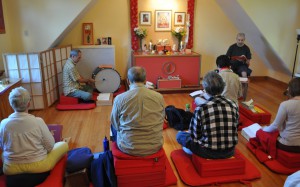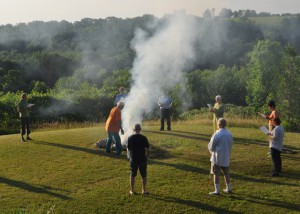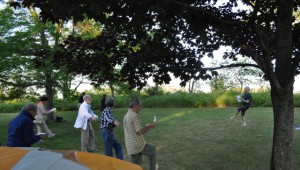Wednesday
Scene and HeardFirst Mahamudra Retreat in Ontario
The swirling white smoke of a lhasang marked the beginning of a 7-day Mahamudra retreat for a group of tantrikas from the Toronto Shambhala Center. The location chosen was the Juniper Hill Retreat Center, located some 2 hours northeast of Toronto.
The retreat was led by Jay Lippman of Philadelphia. In the early nineties Khenpo Tsultrim Gyamtso, on invitation of the Sakyong, started a stream of Mahamudra teachings at Karme Choling and other land centers, which Jay was able to attend. Over the years he had become a keen student of mahamudra so much so that the Khenpo encouraged and authorized him to present these mahamudra teaching to Shambhala tantrikas.
Khenpo Tsultrim Gyamtso is one of the few remaining great Buddhist masters who received their training in the Tibet of old. Born into a nomad family in Eastern Tibet he spent many years undertaking retreats in caves and charnel grounds. He is renowned for possessing the intellect and knowledge of a scholar and the realization, humor and creativity of a yogi.
The Khenpo’s teachings on mahamudra are quite unique. Following closely the famous text of the ninth Karmapa called, The Ocean of Definitive Meaning, he leads his students slowly and step by step along the path through the various meditation practices. Throughout the shamatha section there are a wide number of meditations, object of meditations and approaches offered, which students can apply and accomplish. It is in the vipashyana section that the meditators can develop the insights to eventually gain a direct experience of the nature of mind. Long hours were spent with practicing the mahamudra investigations, looking at mind from every conceivable angle. The students were already familiar with the transcripts of the Khenpo expounding the view of mahamudra and the method of his style of teaching. In order to prepare for this retreat the participants had already attended four weekends with Jay, spread out over two years, studying and practicing these precious teachings.
Although Jay Lippman had been teaching various programs throughout the wider sangha for some time, it is the mahamudra teachings, which are closest to his heart. He brings tremendous patience, intuition and a solid understanding of the material to the task. Having made it the cornerstone of his daily practice as well as having practiced it in retreats, he has personally achieved some of the insights that mahamudra is about. With this comes the ability to see where students are and to lead them further.
 The retreat was conducted in silence; the first three days were devoted strictly to shamatha practice, followed by four days on vipashyana. The days started at 6:30 in the morning with lujong on the front lawn in order to limber-up the body for a long day of intensive practice. During the later afternoon some talks and further instructions were offered. Following the well- known adage: in shamatha the teacher talks and the student listens, in vipashyana the student talks and the teacher listens,” the students were periodically asked to describe their experiences. Individual interviews were also conducted. The days ended at 8:30 at night with the singing of a few Songs of Realization from the Khenpo and other great masters.
The retreat was conducted in silence; the first three days were devoted strictly to shamatha practice, followed by four days on vipashyana. The days started at 6:30 in the morning with lujong on the front lawn in order to limber-up the body for a long day of intensive practice. During the later afternoon some talks and further instructions were offered. Following the well- known adage: in shamatha the teacher talks and the student listens, in vipashyana the student talks and the teacher listens,” the students were periodically asked to describe their experiences. Individual interviews were also conducted. The days ended at 8:30 at night with the singing of a few Songs of Realization from the Khenpo and other great masters.
At the end of the retreat, at a free exchange amongst the students it became clear to all that whatever their insights, achievements or experiences might have been, it only scratched the surface of these vast yet subtle teachings, and in order to move further it will need continuous practice and more retreats.
The Juniper Hill Retreat Center proved to be an ideal location for the retreat. Overlooking the rolling hills of the North Humberland County, surrounded by the lush green of the woods and spacious meadows, it naturally invites contemplation. Madeline Conacher and Louis Allen, long time members of Shambhala are running the center with tremendous heart and dedication. This report would not be complete without mentioning the exceptional good meals from Madeline’s kitchen; it would need the skills of a food writer to do any description justice.
The retreat ended with a Werma Feast and in summing up the many toast and comments one message became clear: this is something to be continued.




















Nov 12, 2012
Reply
Hi Russell,
I am looking forward to your report on your second MM retreat.
Helmfried
Sep 17, 2012
Reply
Dear Helmfried,
Thanks for writing this up. We are preparing for our second ten-day mahamudra retreat, and your description adds to the array of skillful means of presenting and adapting this material to our needs. When we finish our retreat, I plan to write a description of that. We will be doing shambhala practices and using mahamudra vipashyana to enhance the completion stage.
–Russell Rodgers